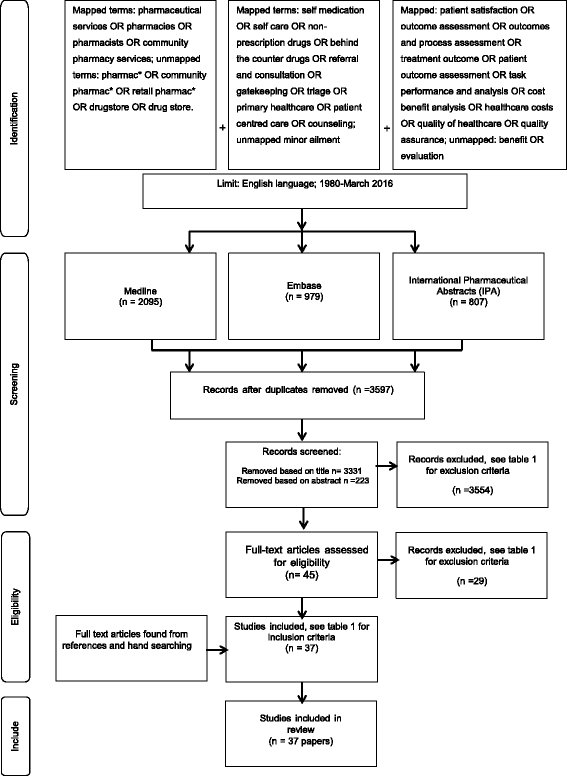Is there potential for the future provision of triage services in community pharmacy?
- PMID: 27708786
- PMCID: PMC5050954
- DOI: 10.1186/s40545-016-0080-8
Is there potential for the future provision of triage services in community pharmacy?
Abstract
Background: Worldwide the demands on emergency and primary health care services are increasing. General practitioners and accident and emergency departments are often used unnecessarily for the treatment of minor ailments. Community pharmacy is often the first port of call for patients in the provision of advice on minor ailments, advising the patient on treatment or referring the patient to an appropriate health professional when necessary. The potential for community pharmacists to act as providers of triage services has started to be recognised, and community pharmacy triage services (CPTS) are emerging in a number of countries. This review aimed to explore whether key components of triage services can be identified in the literature surrounding community pharmacy, to explore the evidence for the feasibility of implementing CPTS and to evaluate the evidence for the appropriateness of such services.
Methods: Systematic searches were conducted in MEDLINE, EMBASE and International Pharmaceutical Abstracts (IPA) databases from 1980 to March 2016.
Results: Key elements of community pharmacy triage were identified in 37 studies, which were included in the review. When a guideline or protocol was used, accuracy in identifying the presenting condition was high, with concordance rates ranging from 70 % to 97.6 % between the pharmacist and a medical expert. However, when guidelines and protocols were not used, often questioning was deemed insufficient. Where other health professionals had reviewed decisions made by pharmacists and their staff, e.g. around advice and referral, the decisions were considered to be appropriate in the majority of cases. Authors of the included studies provided recommendations for improving these services, including use of guidelines/protocols, education and staff training, documentation, improving communication between health professional groups and consideration of privacy and confidentiality.
Conclusion: Whilst few studies had specifically trialled triage services, results from this review indicate that a CPTS is feasible and appropriate, and has the potential to reduce the burden on other healthcare services. Questions still remain on issues such as ensuring the consistency of the service, whether all pharmacies could provide this service and who will fund the service.
Keywords: Advice; Community pharmacy services; Patient outcome assessment; Pharmacist; Primary health care; Referral; Triage.
Figures
Similar articles
-
Evaluation of a new patient consultation initiative in community pharmacy for ear, nose and throat and eye conditions.BMC Health Serv Res. 2019 May 3;19(1):285. doi: 10.1186/s12913-019-4125-y. BMC Health Serv Res. 2019. PMID: 31053122 Free PMC article.
-
Methodological considerations in clinical outcomes assessment of pharmacy-based minor ailments management: A systematic review.PLoS One. 2018 Oct 4;13(10):e0205087. doi: 10.1371/journal.pone.0205087. eCollection 2018. PLoS One. 2018. PMID: 30286166 Free PMC article.
-
Involving the public and other stakeholders in development and evaluation of a community pharmacy alcohol screening and brief advice service.Public Health. 2014 Apr;128(4):309-16. doi: 10.1016/j.puhe.2013.11.001. Epub 2014 Apr 6. Public Health. 2014. PMID: 24713598
-
How to enhance public health service utilization in community pharmacy?: general public and health providers' perspectives.Res Social Adm Pharm. 2014 Mar-Apr;10(2):272-84. doi: 10.1016/j.sapharm.2012.05.006. Epub 2012 Oct 23. Res Social Adm Pharm. 2014. PMID: 23089293
-
Advice-giving in community pharmacies in the UK.J Health Serv Res Policy. 1997 Jan;2(1):38-50. doi: 10.1177/135581969700200109. J Health Serv Res Policy. 1997. PMID: 10180653 Review.
Cited by
-
Effective communication and collaboration with health professionals: A qualitative study of primary care pharmacists in Western Australia.PLoS One. 2020 Jun 11;15(6):e0234580. doi: 10.1371/journal.pone.0234580. eCollection 2020. PLoS One. 2020. PMID: 32525923 Free PMC article.
-
Strengthening patients' triage in community pharmacies: A cluster randomised controlled trial to evaluate the clinical impact of a minor ailment service.PLoS One. 2022 Oct 25;17(10):e0275252. doi: 10.1371/journal.pone.0275252. eCollection 2022. PLoS One. 2022. PMID: 36282834 Free PMC article. Clinical Trial.
-
Patient uptake and outcomes following pharmacist-initiated referrals to general practitioners for asthma review.NPJ Prim Care Respir Med. 2022 Nov 17;32(1):53. doi: 10.1038/s41533-022-00315-6. NPJ Prim Care Respir Med. 2022. PMID: 36384948 Free PMC article.
-
Medicine and the future of health: reflecting on the past to forge ahead.BMC Med. 2016 Oct 25;14(1):169. doi: 10.1186/s12916-016-0717-0. BMC Med. 2016. PMID: 27776546 Free PMC article.
-
Identification of high-risk patients for referral through machine learning assisting the decision making to manage minor ailments in community pharmacies.Front Pharmacol. 2023 Jul 11;14:1105434. doi: 10.3389/fphar.2023.1105434. eCollection 2023. Front Pharmacol. 2023. PMID: 37497107 Free PMC article.
References
-
- Evans R et al. Apocalypse No : population aging and the future of health care systems. Social and Economic Dimensions of an Ageing Population, 2001. Research paper 59.
-
- Cornwall J, JA. Davey. Impact of population ageing in New Zealand on the demand for health and disability support services and workforce implications New Zealand Institute for Research on Ageing (NZiRA) and the Health Services Research Centre (HSRC), Victoria University of Wellington. 2004. https://www.health.govt.nz/system/files/documents/publications/cornwalla.... Accessed 30 Sept 2016.
Publication types
LinkOut - more resources
Full Text Sources
Other Literature Sources
Miscellaneous

